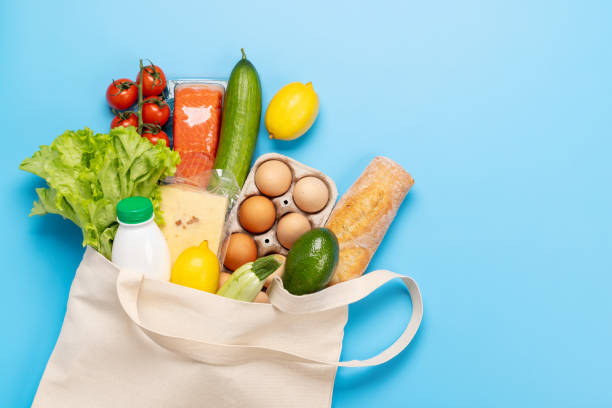Maintaining a healthy lifestyle in our fast-moving world begins when you pick up what goes into your shopping cart. These important choices in the grocery store form the basis of good nutrition.

We are well aware that as we move towards an unhealthy lifestyle, it becomes more essential to maintain a well-curated healthy food list grocery so that you can feed your body with the basic nutrients it needs, preventing all kinds of chronic diseases and reducing weight while increasing energy levels.
This blog post is simple and detailed to create a healthy grocery list covering every food group. This list is for you if you’re a busy professional, student, fitness lover, or just starting your health journey — we will help you have better eating habits with this grocery list.
What to Include in a Healthy Grocery List
Now, before we hop into the list, let me emphasize the importance of a healthy grocery list:
1. Decreases the risk of chronic diseases — A wholesome grocery list reduces the risk of chronic conditions such as diabetes, heart disease, and obesity.
2. Save money: If you plan ahead, you won’t eat out or buy things you don’t need.
3. Reduces stress: If you have determined all the ingredients to be purchased, shopping becomes easy and saves time.
4. Promotes mindful eating: Planning your groceries means you tend to eat better and also control your portions.
How to Create a Healthy Grocery List
Learning the major food groups and choosing foods from each to fit your program is the start of building a healthy grocery list.
Let’s take a look at food categories:
Fruits
Fruits also contain a lot of vitamins, fiber, and antioxidants. Seek out diversity and color in your cart.
Healthy Fruit Options:
Apples
Bananas
Oranges
Berries (strawberries, blueberries, raspberries)
Grapes
Kiwi
Pineapple
Papaya
Avocado (technically a fruit)
Mango
Watermelon
Cantaloupe
Tips: Select fresh, frozen (no sugar added); or canned in water or natural juice.
Vegetables
Veggies are nutrient-dense and low in calories, supplying fiber, vitamins A, C, and K, potassium, and so very much more.
Healthy Vegetable Options:
Salad greens (spinach, kale, arugula, romaine)
Broccoli
Cauliflower
Carrots
Bell peppers
Zucchini
Tomatoes
Cucumbers
Mushrooms
Sweet potatoes
Beets
Tips: Pick a rainbow of colors for variety in nutrients. Select fresh or frozen without sauces.
Whole Grains
Whole grains: Packed with fiber and vital B vitamins, whole grains will sustain your energy.
Healthy Whole Grain Options:
Brown rice
Quinoa
Oats (steel-cut or old-fashioned)
Whole wheat bread
Whole grain pasta
Barley
Farro
Bulgur
Buckwheat
Millet
Tips: Look for “100% whole grain” or “whole wheat” as the first ingredient on all labels.
Lean Proteins
Protein is crucial for muscle repair, immunity, and energy levels.
Healthy Protein Sources:
Chicken breast (skinless)
Turkey
Eggs
Fish (salmon, tuna, sardines, mackerel)
Even lean cuts of beef or pork (sirloin, tenderloin)
Tofu
Tempeh
Edamame
Greek yogurt (plain)
Cottage cheese
Lentils
Chickpeas
Beans (black beans, kidney beans, navy beans)
Recommendations: Choose grilled, baked, or steamed rather than fried. Plant-powered proteins are good for your heart.
Dairy and Dairy Alternatives
They include calcium, vitamin D, and protein.
Healthy Options:
Low-fat or fat-free milk
Almond milk, soy milk, oat milk (unsweetened)
Greek yogurt (plain or low sugar)
Low-fat cheese (mozzarella, feta, cottage cheese)
Kefir (fermented dairy)
Tips: Unsweetened and fortified non-dairy alternatives.
Healthy Fats
Healthy fats support brain function, hormone production, and heart health.
Healthy Fat Sources:
Olive oil (extra virgin)
Avocados
‘Nuts (almonds, walnuts, cashews, pecans)
Seeds(chia seeds, flaxseeds, pumpkin seeds, sunflower seeds)
Nut butters (peanut butter, almond butter)
Fatty fish (salmon, sardines)
Tips: Choose healthy fats and limit saturated fats. Go with small portions, as fats are calorie-dense.
Herbs, Spices & Condiments
These intensify flavor without introducing unhealthy ingredients.
Healthy Options:
Herbs (flat-leaf parsley, cilantro, basil, thyme)
Turmeric, cumin, paprika, cinnamon
Garlic and ginger
Vinegars (apple cider, balsamic, etc.)
Mustard
Salsa (low sodium)
Hot sauce
Soy sauce or low-sodium soy sauce or tamari
Tips: Skip condiments with added sugar or an unhealthy dose of sodium.
Beverages
But hydration is critical to our health, and its importance cannot be overemphasized.
Healthy Beverage Options:
Water (sparkling or still)
Herbal tea (unsweetened)
Coconut water (unsweetened)
Kombucha (low sugar)
Green tea
Tab: Avoid sodas and sugary juices.
Snacks and Pantry Staples
Healthy snacking can aid calorie management between meals and pep up your metabolism.
Healthy Snack Options:
Hummus
Rice cakes
Popcorn (air-popped)
Trail mix (no added sugars, no salt)
Dark chocolate (70% cocoa or higher)
Whole grain crackers
Bars (core protein, low in sugar, higher in fiber)
Pantry Essentials:
Canned beans (low sodium)
Canned tuna/salmon
Tomato paste/sauce (low sodium)
Coconut milk (light)
Whole grain flours (almond flour, oat flour)
Natural sweeteners (honey, maple syrup, stevia)
Sample Healthy Grocery List
Here’s a template healthy grocery list you can draw from:
Produce:
Spinach
Kale
Carrots
Tomatoes
Blueberries
Apples
Bananas
Avocados
Protein:
Chicken breast
Eggs
Canned tuna
Lentils
Grains:
Brown rice
Oats
Whole wheat bread
Dairy/Alternatives:
Greek yogurt
Almond milk (unsweetened)
Healthy Fats:
Olive oil
Chia seeds
Walnuts
Snacks:
Hummus
Popcorn (plain)
Dark chocolate
Beverages:
Herbal tea
Sparkling water
Smart and Healthy Grocery Shopping Tricks
- Organise and plan — Draw a meal plan, thus preparing your grocery list accordingly.
- Shop the perimeter: That’s where the fresh foods tend to be.
- Read labels — Watch for hidden sugars, sodium, and trans fats.
- Buy in bulk: Grains, legumes, and nuts are typically less expensive when purchased in bulk.
- Don’t shop on an empty stomach — You’ll be tempted to impulse buy unhealthy foods.
- Be adventurous — Use seasonal fruits, or a new grain to change it up.
- Buy organic when you can, particularly for fruits and vegetables with thin skins, such as berries and spinach.
- Grocery apps – They keep your list organized, and they share healthy recipes.
FAQs (Frequently Asked Questions)
Q: Is eating healthy costly?
A: Not necessarily. Purchasing entire ingredients, pre-prepping meals and selecting seasonal produce can keep healthy eating low-cost.
Q: How often should I grocery shop?
Q: If someone wanted to cut down on food waste, would you recommend going shopping weekly or biweekly?
Q: Is it O.K. to buy frozen vegetables and fruits?
A: Absolutely! Frozen options are equally nutritious and have a longer shelf life.
Q: Should I avoid carbs?
A: Not all carbs are bad. Opt for complex carbs, such as whole grains, fruits, and vegetables, for sustained energy.
Final Thoughts
Creating a healthy food list for grocery stores is one of the easiest and most potent methods towards bettering your holistic health. It gives you the ability to make wiser food decisions, follow a nutritious diet, and even be more consistent with what you eat.
The secret is to stick to whole and minimally processed foods, and to have a variety of all other food groups. Armed with this extensive list, your grocery runs will be healthier, easier, and more purposeful. Start here today to build your own personalized grocery list and change your health one cart at a time.
